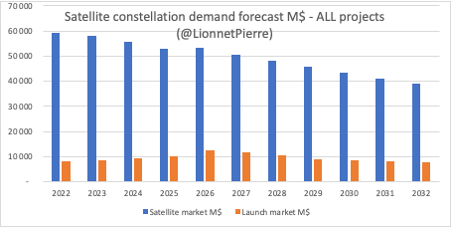
Starlink: 2000 satellites launched (and >10% already decommissioned). Why isn't #SpaceX accelerating the deployment? What is preventing it? Why is it not happening? I would have expected a higher frequency Starlink launch rate at this point (40-50 launches/year at least). 1/
https://twitter.com/elonmusk/status/1482424984962101249
I know that this is not a popular opinion, but I can only see two (non mutually exclusive) reasons for this: 1) Falcon9 is too expensive; 2) Falcon9 turnaround time is too long. Tu put it short: it is not as effective as required. 2/
In a recent talk with Lex Fridman @elonmusk said: "the upper stage is at least 10M$" & "the booster is not as rapidly and completely reusable as we'd like" ... "the minimum marginal cost not counting overhead per flight is on the order of 15 to 20M$" 3/
To me this is a strong hint that the showstopper for #Starlink deployment is Falcon9 that can't keep the required pace. And even if it could, it would be so expensive that it would kill the business case. 4/
At 20M$/launch the deployment of 10000 more Starlinks would require about 200 launches, or 4B$. And that would be without "overhead" (assuming they represent as much as 25% that's 1B$ more). 5/
In order to complete the 12k sats constellation (assuming a 10% premature loss ratio and 5 years lifetime) SpaceX must deploy and additional 2700 sats/yr in the next 4 years. That's >50 F9/yr. 6/
This will require 1B$/yr just to cover the launch "minimum marginal cost", plus at least that much to build the satellites, i.e. 2B$/year for space infrastructure deployment . 7/
With <200k subscribers Starlink yielded less than 250M$ in revenues in 2021, I would then expect SpaceX to become hungry with cash very soon. 8/
And since there are no signs that Starship will be operational in 2022, I would expect to see Falcon9 cadence ramp up significantly to compensate. If it can execute. Which is not sure. 9/
But even at high cadence, the relatively slow Starlink deployment will limit customer acquisition (and revenue growth), in the short/medium term. The constellation may only support 5-600k subscribers by end 2022, and up to 1M by end 2023. 10/
More customers put also a strain on Capex: more terminals and more ground stations. These may add >500M$ of annual Capex to the equation. 11/
So, if all goes 'well' SpaceX will face >2,5B$ Capex in 2022 and as much in 2023, for Starlink alone. In the meanwhile Starlink may generate 500M$ in sales in 2022 and 1B$ in 2023. 12/
That is far from covering the #Starlink Capex needs (I am not even considering operations costs, sales and administration etc.). This is why I believe that SpaceX will keep raising funds in high amounts (>2B$/year) in 2022 and in 2023. 13/
New investors will buy into a 2-decades old cash-strapped company valued >100B$ with annual revenues in the order of 2/3B$ (and a negative EBITDA?). Beyond the sheer personality of @elonmusk does that make for an attractive investment case? 14/
This is where Starship comes in play. If Starship becomes operational in 2023, and eventually performs at the expected low cost, not only the Starlink economic equation will become (slightly) more attractive, but the SpaceX business case shifts. 15/
Starship as a super low cost launch service could disrupt launcher markets (this is a popular opinion). But how much revenues will it generate for SpaceX? How much volume of demand is needed to make it a good business, and at what price? 16/
If Starship can achieve one or two orders of magnitude of cost reduction over Falcon9, SpaceX must pass a good share of these gains to its customers if it really wants to displace the demand curve to reach the volumes it requires for frequent operations. 17/
This is why Starship success, use costs and pricing strategy lay at the heart of SpaceX's future. But Starship is a risky bet: if launch demand does not grow exponentially to justify frequent use of such a large launcher it may not generate enough value for SpaceX. 18/
If Starship is not offered at a very low price from the beginning it will not move the demand curve, and may thus never achieve high cadence (and thus drive down use costs) and will become a money pit. 20/
If Starship use cost is not low enough it will not drive down Starlink's Capex, it will thus hamper Starlink economics, that may then become another money pit. 21/
Eventually, for me the most crucial question of all is "at what price will Starship create a massive new demand?" with its corollary "are there massive space business cases that are enabled exclusively by very cheap access to space?" 22/
And when i say "massive" I mean that would require the launch to LEO of >10000 tons every year, with >100 Starship launches annually (while Starlink would only require 15-20 launches/yr for replenishment...). 23/
I don't know how the SpaceX strategy teams are looking at this issue, and whether they have already a few economic models available, but I'd be damn curious to have a peek at them. 24/
And BTW: I don't think that Mars (or Moon) colonies will create that kind of massive demand around 2024-2025... and not even by 2030 (admittedly, this is not a popular opinion). 25/end
• • •
Missing some Tweet in this thread? You can try to
force a refresh














